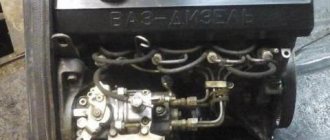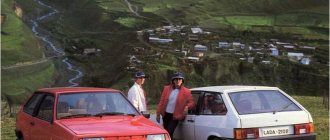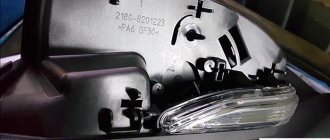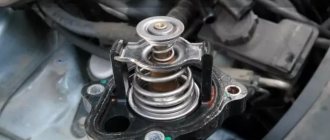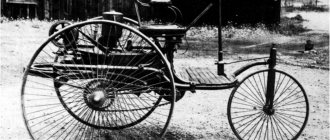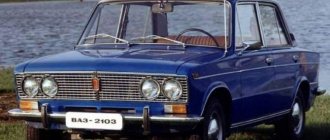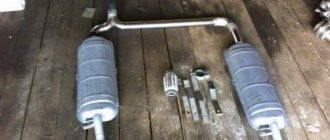Two plus five equals four: the history of the development of the VAZ-2104
Having “promoted” the so-called “Fiat” models, the “kopek” and the VAZ-2103 , to the required level, VAZ first slightly modernized the first one, releasing a modification of the VAZ-21011 , and then really began developing their own models - the all-wheel drive Niva, the “super-luxury” VAZ 2106 , as well as products of deeper intervention in the Fiat platform - we are talking about the “five” and VAZ-2107 . Let's not forget that by the beginning of the eighties, a fundamentally new model was almost completely ready - the first front-wheel drive hatchback VAZ-2108 . Thus, almost the entire model range was thoroughly shaken up for the new decade. And only the VAZ-2102 station wagon was produced without any special changes, although the base model 2101 was noticeably outdated by that time. There was no point in upgrading it “to level zero eleven” - the absence of fangs on the bumpers and a different number of vertical slats on the radiator grille would hardly have made the “kopeck piece” more modern. The conclusion suggested itself: the new station wagon model had to be produced on the basis of the most modern Zhiguli of the fifth family.
Sales markets
Despite the fact that the USSR has always traditionally loved sedans, five-door station wagons were popular and in demand among both summer residents and residents of rural areas. They drove cars “on business” - that is, they usually used them to transport goods, furniture or gardening equipment. The station wagon, for all its shortcomings, had one huge advantage - with the rear seat folded down, an impressive platform was formed inside, which made it possible to transport both large household appliances and long items.
The “spacious belly” of the VAZ-2102 was appreciated both in the Soviet Union and abroad
The owners of the “two” quickly realized the charm of their car, which, with its “Zhiguli” dimensions, made it possible to transport substantial “swag” inside (and not on the roof!). That is why, by the early eighties, the VAZ station wagon had formed a stable circle of admirers on the domestic market, which was aggravated by the relatively small production volumes of this model compared to sedans.
1 / 5
2 / 5
3 / 5
4 / 5
5 / 5
But five-door Zhigulis were in demand not only on the domestic market: in the countries of Eastern and even Western Europe, Soviet station wagons were also actively purchased, although for slightly different reasons.
1 / 4
2 / 4
3 / 4
4 / 4
Europeans associated this type of body with an active lifestyle, allowing them to transport various sports equipment. In addition, tight-fisted residents of small towns and villages also appreciated the extraordinary cargo capabilities of the “Soviet Familiare”.
1 / 4
2 / 4
3 / 4
4 / 4
But by that time Fiat had long since discontinued sedans and station wagons based on the 124th model platform, and the “naive, round-eyed” two-piece looked archaic even by the standards of socialist camp motorists who were not too spoiled by modern technology. And the further it went, the more it was felt - interest in the first models began to noticeably fade away. But every exported Zhiguli means foreign exchange earnings, which were more important for the Soviet economy than their own “wooden” ones, which were used to pay buyers of Zhigulis within the country. That is why the new station wagon had to appear in a short time - if there is demand, then according to the laws of a market economy there must be supply.
Fifth base
The fifth family was not given to the plant too easily: the desire to modernize the Zhiguli, produced on the Fiat platform of the mid-sixties, as much as possible was not best combined with technological and financial limitations. It was impossible to touch the doorways and the roof, but at the same time it was necessary to “pull up” the classics to the standards of the early eighties. In essence, it was necessary to make a new one out of an old car, limiting itself to minimal changes.
1 / 2
2 / 2
As a result, it was possible to “squeeze out” almost everything from the plan: thanks to the angular shapes, the “five” received a much more modern body in appearance, and the interior, compared to the “penny”, has changed radically. After all, not only completely different upholstery parts, seats and dashboard appeared in the interior, but also more efficient ventilation and heating systems. The new image was complemented by large block headlights and large rear lights - no worse than on similar “foreign cars” of those years!
1 / 2
2 / 2
In particular, the Fiat 131 had similar solutions for the front end - probably when developing the “five” it could not have been done without a thoughtful analysis of Italian innovations.
1 / 5
2 / 5
3 / 5
4 / 5
5 / 5
However, the VAZ-2105 differed from the first Zhiguli model not only in appearance, but also in the engine: the 1300 cc power unit received a drive innovation - a toothed belt in the gas distribution mechanism drive instead of a classic chain. And so that if the belt breaks, the pistons do not “collide” with the valves, special recesses were provided in the bottoms of the piston group. The ignition and power systems have become more modern, making the “zero fifth” engine quieter, more economical and environmentally friendly.
The VAZ-2105 has been noticeably modernized not only visually
In addition, a vacuum booster appeared in the brake system, and the rear brake mechanisms were equipped with “self-feeding” cylinders, so that adjustment of the gap between the drum and the pads was no longer required.
The Five has become noticeably easier to drive thanks to the upgraded steering and new radial tires of the MI-166 model.
2+5=4
When creating a new model, the designers needed to connect the “new” platform from the VAZ-2105 with the rear part of the station wagon, because one of the most expensive stamps (roof panel) had to remain unchanged, and the doorways, by analogy with the “five”, retained their kinship with "kopeck piece".
1 / 3
2 / 3
3 / 3
Of course, the shape of the outer panels of the rear doors and rear wings needed to be consistent with the “five-point” ones - that is, to “square” them somewhat, and instead of the naive narrow flashlights from the Fiat 124 Familiare, the new model required appropriate lighting equipment - rectangular and much larger in size. At the same time, for better visibility, the rear window was enlarged, because the door of the new car was original. In accordance with the trends of those years, a rear window cleaner and heated rear window were included as additional equipment. Perhaps now such an “option” seems ridiculous, but in the USSR only a few cars were equipped with it.
1 / 2
2 / 2
By the end of 1980, specialists from the Office of the Chief Designer of VAZ had prepared the necessary technical documentation - that is, the “four” was ready to go into production just at the moment when the VAZ-2105 began to roll off the assembly line.
However, due to the launch of the “Seven” series and preparations for the production of the VAZ-2108, the new station wagon had to “languish in anticipation” a little. Only in 1983 was it possible to weld, paint and assemble the first “living prototypes”, and the pilot production batch of VAZ-2104 rolled off the assembly line in the summer of 1984.
1 / 2
2 / 2
Thus, the “four” waited for their turn for several years. Over the remaining six months in 1984, they planned to assemble over 5,000 new station wagons, but for various reasons, three times fewer cars were produced.
The model's informational debut took place in the January 1985 issue of Za Rulem magazine.
1 / 4
2 / 4
3 / 4
4 / 4
The planned design capacity was reached almost simultaneously with the discontinuation of the “kopeck piece” - that is, throughout 1985, and since 1986, over 50,000 “fours” rolled off the assembly line annually.
1 / 5
2 / 5
3 / 5
4 / 5
5 / 5
No retirement
The high demand for the new station wagon turned out to be stable - especially since there were no cars with this type of body in the front-wheel drive family, and the “four” did not seem outdated at all compared to the rest of the rear-wheel drive model range.
1 / 5
2 / 5
3 / 5
4 / 5
5 / 5
In Europe, dealers offered to increase the load capacity of the VAZ-2104 using a roof box
1 / 3
2 / 3
3 / 3
“Four” overseas: there was a Signet model for the Canadian market
That is why the car was produced without any special changes until 2012 - that is, almost thirty years!
The “Four” underwent a slight modernization in parallel with the base fifth model, and after the “native” belt-driven engine was discontinued, most modifications with the index 21043 were equipped with the good old VAZ-2103 engine.
Most of the “fours” were produced with a one and a half liter VAZ-2103 engine
There was an export modification with a 1700 cc engine equipped with a distributed fuel injection system
However, in the late nineties there was an attempt to convert station wagons to heavy fuel, but the “fours” with the VAZ-341 vortex chamber diesel engine never became widespread.
“Seven” front end and wheels of the VAZ-2108 – this is what the cars of the last years of production, manufactured outside of Tolyatti, looked like
The “chubby” steering wheel gives out a late “four”
There was also a modification with a “seven” interior, but in the early years it could only be found abroad
1 / 2
2 / 2
1 / 2
2 / 2
In addition to Togliatti, this model was produced both in the near and far abroad: since 2001, the “four” from Russian vehicle kits began to be assembled at several Ukrainian car factories - in Lutsk, Kherson and Kremenchug, and at the same time, using SKD technology, the assembly of VAZ- 2104 was established in...Egypt!
The Volzhsky car was produced until 2004 - later in Tolyatti in this form factor it was completely replaced by the VAZ-2111, and production was moved to Izhevsk and Syzran. The later “fours” received a distributed fuel injection system instead of an archaic carburetor, a five-speed gearbox and new front seats, but in the “zero” years, interest in the car began to gradually decline - by that time the “four” had become too outdated and unassuming compared to other cars , including new Russian station wagon models, among which are the Togliatti Kalina and Priora. Nevertheless, until September 2012, the VAZ-2104 was produced at the IzhAvto plant, which provided the second VAZ station wagon with the charisma of a real long-liver.
Design features
Since the front part of the car is identical to models with a sedan body, it is more difficult for a standard heater to warm a larger volume of the interior during the cold season. The back of the car often fogs up in cold weather. The car normally does not have rear ventilation holes for venting interior air (unlike the VAZ-2107), which makes it difficult to close the doors (with the windows closed). Compared to the VAZ-2105, 2107 (with identical engine installations), it has a lower maximum speed (data from the “operating instructions” ~ 137 km/h versus ~ 142 km/h) due to the changed final drive ratio - 4, 44 (early modifications) versus 4.3 on the sedan. The rear door is subject to contamination by road dirt (dust raised by wheels), which is locally drawn when driving at high speeds into the low-pressure zone - this is corrected by installing an upper deflector on the 5th door, supplying (to the low-pressure zone) cleaner air from the roof. There is also a way to avoid the accumulation of dirt on the back door - this is to change the design of the rear bumper - the lower part must be bent in the opposite direction and the gap between the bumper and the body must be closed - a plate 1 meter by 15 cm in the middle. The gas tank with a volume of 43 liters (versus 39) is located horizontally under the bottom of the trunk without additional protection - there is a risk of damage when driving over rough terrain.
Diesel modification
In 1999, a modification of the VAZ 21045
with a VAZ-341 diesel engine produced by Barnaultransmash with a volume of 1.52 liters and a Bosch injection pump.
Since 2005, it was planned to install a more powerful version of a 1.8-liter diesel engine (modification of the VAZ-21048
), but these plans remained unrealized[4].
The diesel modification was distinguished by a significantly higher cost and lower power of the power plant, despite the fact that in these years diesel fuel was noticeably cheaper than gasoline, the economic feasibility of purchasing this version was in doubt [ source not specified 2287 days
].
In 2004, production of the VAZ-21045 was discontinued; the remaining unspecified diesel engines in the amount of 500 pieces were equipped with a batch of the new modification VAZ-21055[5].
Differences from the petrol version
- additional sound insulation of the engine compartment;
- reinforced front suspension springs;
- main pair 3.91 (petrol 4.1);
- exhaust pipe wrapped in a loop (to avoid contamination of the right lamp with soot);
- on the control panel: the presence of a fuel filter heating key, as well as a glow plug heating indicator[6].
Notes
- Until 2003, it was produced at AvtoVAZ, then production was transferred to the IzhAvto conveyor. In addition, at the RosLada plant in Syzran, production of the VAZ-2104 with diesel engines began, but it was soon curtailed. IzhAvto produced the “four” in various configurations from 2003 to 2009 (source: “Autolegends of the USSR” magazine), then production was stopped due to financial difficulties. However, since September 2010, the plant resumed production of the LADA 2104. Production of the car at IzhAvto ceased on September 17, 2012
- The maximum permitted weight is indicated in brackets, and the curb weight is indicated outside the brackets.
- IzhAvto completes production of Lada 2104
- O. Gordeeva.
The diesel “four” with 1.8 will appear in two years
(unspecified)
. ZR (April 25, 2003). - Diesel "five" (undefined)
.
Wheel
. ZR (No. 10, 2003). - You drive more quietly, you smell of diesel fuel... (unspecified)
(inaccessible link). ZR (No. 4, April 2000). Access date: October 19, 2015. Archived March 5, 2016.
Modifications
Scale model of VAZ-21043
- VAZ-2104 - VAZ-2105 engine, 1.3 liters, carburetor, with a 4-speed gearbox, base model.
- VAZ-21041 - VAZ-2101 engine, 1.2 liters, carburetor with 4-speed. Checkpoint. Not serially produced.
- VAZ-21042 - VAZ-2103 engine, 1.5 liters, carburetor, right-hand drive.
- VAZ-21043 - VAZ-2103 engine, 1.5 liters, carburetor with 4- or 5-speed. Checkpoint.
- VAZ-21044 - VAZ-2107 engine, 1.7 liters, single injection, 5-speed. Gearbox, export model.
- VAZ-21045 - VAZ-2107 engine, 1.8 liters, single injection, 5-speed. Gearbox, export model. Not serially produced.
- VAZ-21045D - VAZ-341 engine, 1.5 liters, diesel, 5-speed. Checkpoint.
- VAZ-21046 - VAZ-2105 engine, 1.3 liters, 4-speed gearbox, right-hand drive.
- VAZ-21047 - VAZ-2103 engine, 1.5 liters, carburetor, 5-speed. Gearbox, interior and electrical equipment from VAZ-2107.
- VAZ-21048 - VAZ-343 engine, 1.77 liters, diesel, 5-speed. Checkpoint.
- VAZ-21041i - VAZ-21067 engine 1.6 liter injector, 5-speed gearbox, interior and electrical equipment of VAZ-2107, front seats from Izh-2126.
- VAZ-21041 VF - design of the VAZ-2107 radiator, VAZ-2103 engine 1.5 liter injector, 5-speed gearbox, interior and electrical equipment of the VAZ-2107, front seats from IZH-2126.

